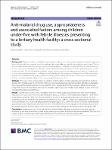| dc.contributor.author | Nyeko, Richard | |
| dc.contributor.author | Otim, Felix | |
| dc.contributor.author | Obiya, Evelyn Miriam | |
| dc.contributor.author | Abala, Catherine | |
| dc.date.accessioned | 2023-03-21T07:48:02Z | |
| dc.date.available | 2023-03-21T07:48:02Z | |
| dc.date.issued | 2023 | |
| dc.identifier.citation | Nyeko, R., Otim, F., Obiya, E.M., and Abala, C. (2023). Anti-malarial drug use, appropriateness and associated factors among children under-five with febrile illnesses presenting to a tertiary health facility: a cross sectional study | en_US |
| dc.identifier.uri | https://link.springer.com/content/pdf/10.1186/s12936-023-04534-1.pdf | |
| dc.identifier.uri | http://ir.lirauni.ac.ug/xmlui/handle/123456789/519 | |
| dc.description.abstract | Background Malaria is endemic in 95% of Uganda and constitutes the country’s most signifcant public health prob lem—being the leading cause of morbidity and mortality, especially among children under fve years of age. The cur rent national malaria treatment policy is to use artemisinin-based combination therapy (ACT) as frst-line treatment,
and recommends parasitological confrmation of malaria before therapy. Adherence to this policy, however, remains
suboptimal, with the self-initiated home-based therapy being common—posing undue exposures to, and pressure
on the current artemisinin-based combinations, with the danger of emergence of drug resistance. The study evalu ated the anti-malarial use and its appropriateness among febrile children under fve presenting to a tertiary health
facility in northern Uganda in light of the current malaria treatment policy.
Methods This was a cross-sectional study in a tertiary health facility in northern Uganda between March and Sep tember 2021. Children aged 6–59 months with fever were selected using systematic random sampling. A pretested
interviewer-administered questionnaire was used to collect clinical data from the caregivers. Data were analysed
using SPSS version 23. Descriptive statistics and multiple logistic regression models were applied. P-value<0.05 was
considered for statistical signifcance.
Results Seventy-two (34.3%) of the 210 children with fever in this study used anti-malarials prior to the hospital
visit, 29.2% (21/72) of which were on a self-medication basis, 22.2% (16/72) were empiric prescriptions—all of which
inappropriate, and only 48.6% (35/72) were prescribed based on a parasitological diagnosis of malaria. The most
commonly used anti-malarials were artemether-lumefantrine 60/72 (88.3%), while a lesser proportion of quinine 7/72
(9.7%), artesunate 3/72 (4.2%) and dihydroartemisinin-piperaquine 2/72 (2.8%) were used. The factors independently
associated with anti-malarial use among the children with febrile illnesses were duration of fever (p=0.001); level of
the nearest facility (p=0.027), distance from the nearest health facility (p=0.025), and caregivers’ age (p=0.038).
Conclusions Inappropriate use of anti-malarials for childhood febrile illnesses is prevalent in the study setting,
facilitated by the ease of over-the-counter access, empiric prescription and use of leftover anti-malarials. This calls for a
need to address communities’ health-seeking behaviour and the health providers’ practice alike. | en_US |
| dc.language.iso | en | en_US |
| dc.publisher | Malaria Journal | en_US |
| dc.subject | Anti-malarial | en_US |
| dc.subject | Febrile illnesses | en_US |
| dc.subject | Children | en_US |
| dc.subject | Appropriateness | en_US |
| dc.subject | Over-the-counter | en_US |
| dc.subject | Self-medication | en_US |
| dc.subject | Empiric prescription | en_US |
| dc.title | Anti-malarial drug use, appropriateness and associated factors among children under-fve with febrile illnesses presenting to a tertiary health facility: a cross sectional study | en_US |
| dc.type | Article | en_US |

